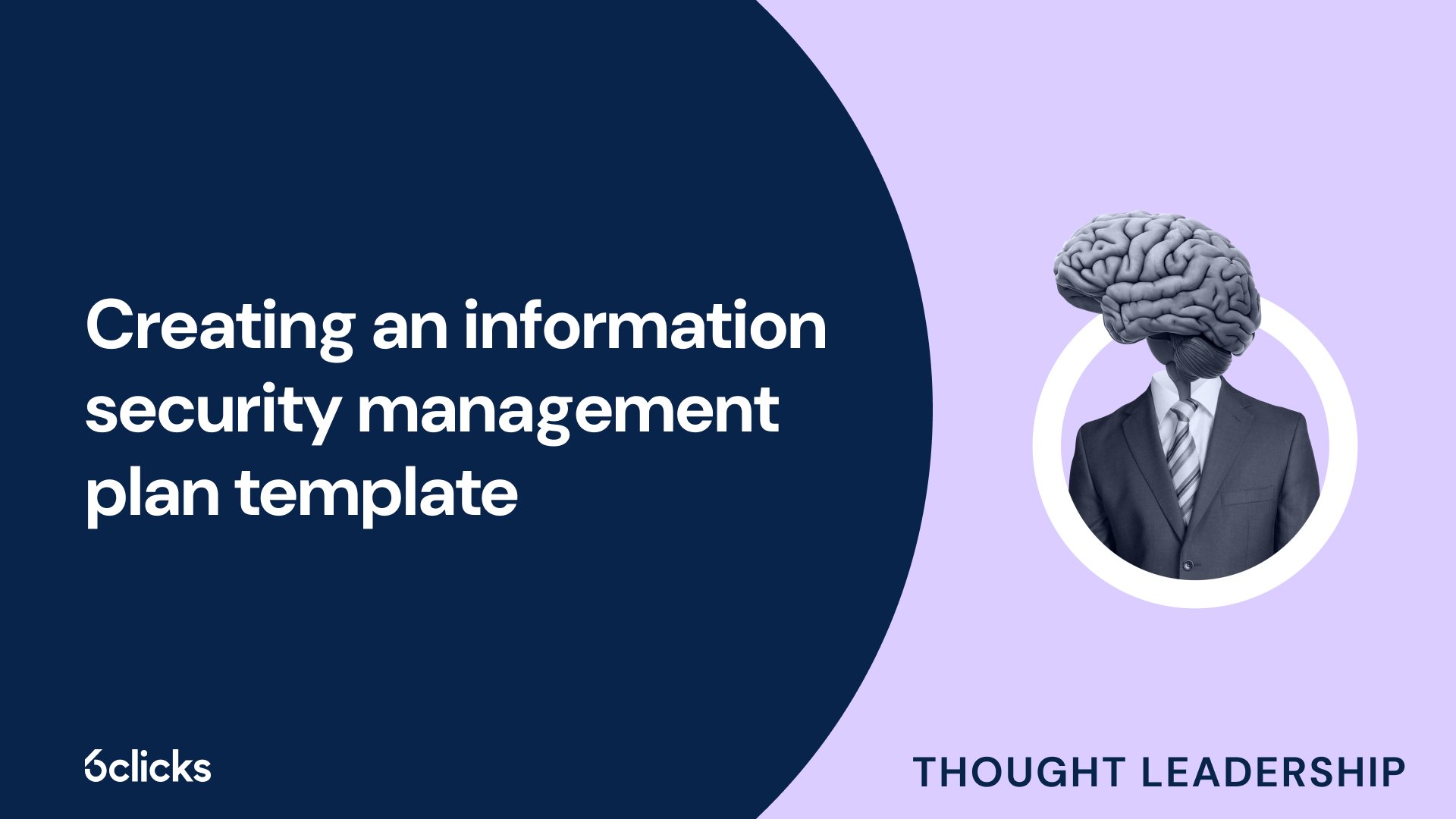In today’s predominantly digital world, protecting sensitive information has become more important than ever. An information security management plan is essential to effectively manage cybersecurity risks and safeguard valuable data. But creating one from scratch can be overwhelming. This step-by-step guide will help you create an information security management plan template and walk you through the process starting from understanding the importance of information security to implementing necessary measures. Learn more below:
Importance of an information security management plan
As data is at the heart of any business, threat actors continuously seek ways to access, steal, and manipulate sensitive information, causing significant disruptions and damages. An information security management plan (ISMP) is crucial as it serves as a comprehensive framework that outlines how an organization protects its data. By establishing a structured approach to managing information security, organizations can systematically identify vulnerabilities, mitigate risks, and implement appropriate safeguards. This structured methodology not only helps in protecting confidential data but also aligns security measures with business goals and regulatory requirements.
An ISMP also allows organizations to:
- Foster a culture of security awareness
- Respond to incidents swiftly and effectively
- Mitigate the impact of incidents
- Preserve stakeholder trust
Key components of an ISMP
An effective information security management plan comprises several key components that work together to create a holistic security framework.
- Risk assessment: First and foremost, the plan should include a thorough risk assessment process. This involves identifying potential threats and vulnerabilities within the organization, evaluating the impact of these risks, and determining the likelihood of their occurrence. By understanding the specific risks faced by the organization, leadership can prioritize security initiatives and allocate resources accordingly.
- Risk management framework: Implementing established risk management frameworks is essential for effectively addressing cybersecurity risks. Frameworks such as ISO 27001 and the NIST Cybersecurity Framework (CSF) provide a systematic approach to managing and mitigating risks, guiding organizations in developing robust security measures and aligning them with best practices.
- Security policies and procedures: Another crucial component is the development of clear security policies and procedures. These should outline requirements for data protection, rules for acceptable use of technology, incident response protocols, and other guidelines addressing different aspects of information security. Having well-documented procedures helps standardize responses to security incidents and ensures consistent implementation of security measures across the organization.
- Security controls and safeguards: Organizations should implement a comprehensive set of controls to reduce risks and remediate vulnerabilities. These include administrative controls (training and policy enforcement), technical controls (firewalls, encryption, and access control), and physical controls (facility security and surveillance systems). A balanced combination of these controls helps ensure that security is maintained across all levels of the organization.
- Continuous monitoring and review: Lastly, organizations must regularly assess their security posture, evaluate the effectiveness of existing controls, and make necessary adjustments. This iterative process not only helps in identifying gaps in security but also ensures that the organization remains compliant with industry standards and best practices.
Together, these components form a strong foundation for an information security management plan that can adapt to changes and proactively safeguard sensitive information.
How to create your ISMP template
Follow these steps to start building your information security management plan:
Step 1: Identify and assess risks
The first step is to identify and assess risks associated with information assets. This process begins with a comprehensive inventory of all information assets, including hardware, software, and data. Categorize these assets based on their sensitivity and criticality to business operations, ensuring that the most valuable and vulnerable assets receive appropriate attention.
Once the inventory is established, the next phase involves conducting a risk assessment. This assessment should analyze potential threats, such as cyberattacks, data breaches, natural disasters, and insider threats. Various risk assessment methodologies can be employed, including qualitative and quantitative approaches, to provide an in-depth view of the organization’s risk landscape. Evaluating the likelihood of these threats occurring and their potential impact facilitates effective risk prioritization.
The outcome of this risk assessment should be documented in a risk register, which serves as a living document that tracks identified risks, their assessments, and mitigation strategies. The 6clicks platform provides powerful risk management capabilities, including systematic risk registers with customizable fields and workflows, automatic risk calculation, and built-in reports and risk matrices to help you streamline risk assessments and optimize your risk management process.

Step 2: Establish information security objectives
After identifying and assessing risks, the next step is to establish clear information security objectives that align with the organization's overall goals. These objectives should be specific, measurable, achievable, relevant, and time-bound (SMART). For example, an objective might be to reduce the number of security incidents by 30% within the next year through enhanced training and awareness programs.
Security objectives should also consider the organization's compliance requirements, industry standards, and best practices. Establishing objectives that align with regulatory frameworks, such as DORA for financial entities and HIPAA for the healthcare sector, ensures that the organization remains compliant while also safeguarding sensitive information.
Once security objectives are established, they should be communicated across the organization. Regularly reviewing and updating these objectives is also necessary to ensure that they remain aligned with the organization’s evolving needs and the changing threat landscape. By establishing clear and actionable security objectives, organizations can create a focused roadmap for their information security efforts.
Step 3: Develop security policies and procedures
With security objectives in place, the next step is to develop comprehensive security policies and procedures for protecting information assets. Each policy should clearly define roles and responsibilities, outlining who is accountable for implementing specific security measures.
When developing security policies, it is essential to involve key stakeholders from different departments, including IT, HR, and legal. Additionally, policies should be written in clear, concise language to make them easily understandable for all employees, regardless of their technical expertise.
Policies must undergo a formal approval process with leadership and relevant stakeholders and must then be communicated throughout the organization. This can be achieved through internal communications and training and awareness programs. Regularly reviewing and updating policies is equally important so they remain relevant to the organization.
Step 4: Implement security controls
The implementation of security controls is a critical step in executing an information security management plan. These controls are the specific measures taken to mitigate identified risks and protect sensitive information.
To begin the implementation process, organizations should prioritize security controls based on the risks identified during the assessment phase. Once security controls are implemented, it is essential to monitor their effectiveness continuously. This can be achieved through regular security audits and assessments that evaluate the performance of the controls and identify any gaps that need to be addressed.
6clicks has integrated control management and audit and assessment functionality to help you execute this step easily. Set up and manage your security controls within 6clicks’ Controls module and seamlessly link them to risks, compliance requirements, and other relevant data. Then, streamline audits and assessments using turnkey templates and automated responses using our AI engine, Hailey.
.png?width=1920&height=1080&name=Hero-regulatory-compliance-1%20(1).png)
Step 5: Monitor and review security measures
The ongoing monitoring and review of security measures are vital components of an information security management plan. As threats evolve and new vulnerabilities emerge, organizations must regularly evaluate the effectiveness of their security controls to ensure they remain robust and relevant.
Continuous monitoring can involve automated tools, such as intrusion detection systems, as well as periodic manual assessments, such as security audits and penetration testing. 6clicks’ continuous control monitoring feature allows you to conduct manual and automated tests to verify if controls are working as intended and get real-time alerts of issues and control failures.
In addition to monitoring security controls, organizations should also track security incidents to identify trends and patterns. Analyzing incident data can help organizations understand the effectiveness of their response measures and inform future security strategies. With 6clicks’ integrated incident management capabilities, you can maintain a comprehensive incident log using customizable incident registers, allowing you to collect detailed incident data to help refine your security initiatives.
Build your information security management plan with 6clicks
In conclusion, understanding the importance of information security and following a structured approach enables businesses to safeguard sensitive data and mitigate risks. With 6clicks, you can leverage robust capabilities that can support your organization in developing, implementing, and maintaining systems and measures for effective information security management. Discover the power of 6clicks by getting in touch with us today.
Frequently asked questions
How can organizations create an ISMP template?
Organizations can create an ISMP template by following a structured approach, starting with risk identification and assessment, setting security objectives, developing clear policies, and implementing security controls. Continuously monitoring and reviewing security measures ensures ongoing effectiveness. Leveraging tools like 6clicks can streamline risk management, policy and control implementation, and security assessments.
How does an ISMP help in regulatory compliance?
An ISMP ensures organizations meet industry regulations by aligning security practices with frameworks like ISO 27001, NIST CSF, HIPAA, and DORA. It helps systematically document security policies, risk assessments, and incident response plans, making audits smoother. Compliance not only avoids legal penalties but also builds trust with clients and stakeholders.
How can businesses ensure their ISMP remains effective over time?
To maintain effectiveness, businesses should regularly update their ISMP based on evolving threats, technology changes, and business growth. This includes continuous risk assessments, updating security policies, and conducting tests and audits. Leveraging automation tools for monitoring and reporting can also enhance efficiency and accuracy in security management.
Written by Heather Buker
Heather has been a technical SME in the cybersecurity field her entire career from developing cybersecurity software to consulting, service delivery, architecting, and product management across most industry verticals. An engineer by trade, Heather specializes in translating business needs and facilitating solutions to complex cyber and GRC use cases with technology. Heather has a Bachelors in Computer Engineering, Masters in Engineering Management, and a Doctorate in Information Technology with a specialization in information assurance and cybersecurity.









